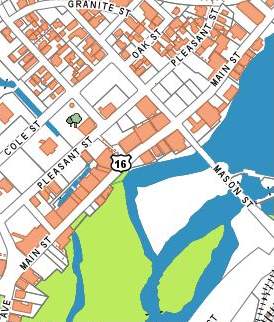
Main Street, Pleasant Street and nearby commercial streets in the area of the Dead River. Later expanding northward to Mason Street
One of two villages in early Berlin, what is now Downtown Berlin was originally known as Berlin Falls. In 1888, a writer described his impression upon arriving in Berlin in 1867, “What is now Main Street, was then a very poor road through a poorer country. Nothing but mud underfoot, rain overhead, a few shabby buildings on one side, and the most uninviting collection of bushes and rocks imaginable on the other. . . It scarcely seems possible that at that time there were only thirty-six buildings in what is now the two villages, including the stores, mills and dwellings (Berlin Independent 4/11/1888).
The following excerpt is from the NHDHR Downtown Historic District Area Form (Richards/Hengen 2009)
By [1888], the town had …. sprouted wood-framed construction in seemingly all directions outward from Post Office Square….The largest natural feature in the central businesses district, besides the Androscoggin River, was Dead River Pond, created in the 1820s as a power source for early grist and saw mills. The pond would remain a physical constraint on downtown Berlin’s consolidation as the central businesses district until about 1920 when it was drained and the river channelized. The other more obvious, but invaluable natural constraint, was the Androscoggin River on the east side of Main Street. At this time, the river literally passed within a few feet of buildings along Main, which was subject to repeated flooding in an era before effective flood control…
During the period [1890-1930], Berlin was literally growing like a western frontier boomtown as the American paper industry grew to dominate world production, and Berlin’s paper mills constantly expanded and hired more workers. With the increasing importance of the Grand Trunk railroad depot (off Post Office Square) for shipping and receiving, Berlin Falls’ one-time rival Berlin Mills Village, was thoroughly eclipsed. Likewise, Gorham to the south was no longer a competing market alternative. As noted previously,
Berlin’s population nearly doubled every 10 years between 1870 and 1900, and the town became a city both in density and government. With increasing prosperity and a burgeoning population creating its own market demands, the downtown grew correspondingly. Several factors however either constrained or threaten that growth.
While the mill pond hampered physical expansion of the downtown westward, the threat of fire within the increasingly dense Main Street made business wary of investing too much too quickly. Eventually, aided by mutual interest of the paper-mill owners, the Androscoggin was dammed at points through the city and channelized into a canal that appreciably decreased the thread of flooding. But even when the canal waters were further contained by the 1920s into an enclosed sluiceway the threat never fully subsided.
Fire, on the other hand was a man-made hazard that Berlin was determined to manage through better firefighting and improved “fire proof” construction. Following a series of devastating fires, which destroyed several different commercial blocs in the winter of 1904-05, the city created a fire district mandating masonry-framed construction. Fortunately, this event coincided with an exceptionally prosperous period for local businesses and seemed to catalyze a boom in new brick commercial construction through the downtown. An article published October 26, 1905 in The Berlin Reporter noted: “It is safe to say that in the three years past since the building boom started, over $4.5 million have been spent on improvements, $1 million of which has been put out this season. During the first two years of the period, the mill work figured very heavily. Outside of that, a block-building epidemic started ……
By 1910, with the population up to 11,789, Main Street had largely been transformed into a commercial avenue of three and four story brick blocks with little or no daylight between them. The street and sidewalks were still mostly dire; a single trolley track ran up the middle of Main Street connecting Berlin to Gorham downriver.
For the next twenty years, the largest single change in the downtown’s center of gravity was the shift northward from Post Office Square to the intersection of Mason and Main Streets, initiated in 1892 when the first vehicular bridge across the Androscoggin opened here, connecting a large but heretofore undeveloped portion of the city across the river with the central shopping district. Gradually, as the east side of the river developed….business interests realized that a substantial portion of their customer base was streaming over this single bridge on a daily basis. Recalling the golden rule of real estate placement, business owners started to migrate northward toward the better location; civic and governmental functions began to follow. The trolley line, which opened in 1902, and the now paved Main Street with raised sidewalks, further helped reinforce the migration as access for the average person was improved.”







 Follow
Follow